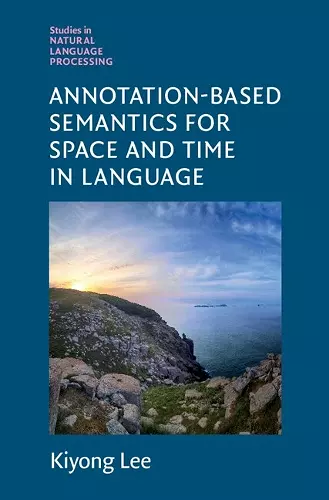Annotation-Based Semantics for Space and Time in Language
Format:Hardback
Publisher:Cambridge University Press
Published:29th Jun '23
Should be back in stock very soon

This book develops natural language semantics for spatio-temporal information based on annotation structures rather than syntax.
Aimed at linguists and computer scientists working on natural language processing, this is the first book that shows, at a large scale, how to do semantics for spatio-temporal information based on annotation structures that conform to ISO international standards such as ISO-TimeML or ISO-Space.Space and time representation in language is important in linguistics and cognitive science research, as well as artificial intelligence applications like conversational robots and navigation systems. This book is the first for linguists and computer scientists that shows how to do model-theoretic semantics for temporal or spatial information in natural language, based on annotation structures. The book covers the entire cycle of developing a specification for annotation and the implementation of the model over the appropriate corpus for linguistic annotation. Its representation language is a type-theoretic, first-order logic in shallow semantics. Each interpretation model is delimited by a set of definitions of logical predicates used in semantic representations (e.g., past) or measuring expressions (e.g., counts or k). The counting function is then defined as a set and its cardinality, involving a universal quantification in a model. This definition then delineates a set of admissible models for interpretation.
'Annotation-based Semantics for Space and Time in Language provides an exhaustive consideration of the syntactic and semantic concerns involved in devising a linguistic annotation scheme. Although focused on spatial and temporal phenomena and presented primarily from the perspective of ISO standardization efforts, Professor Lee's in-depth exposition of the relevant issues will benefit anyone engaged in a linguistic annotation project.' Nancy Ide, Vassar College
'This book draws on the author's decades of experience working on the standardization of semantic annotation as the convenor of an International Organization for Standardization (ISO) working group to develop a formal model-theoretical semantic interpretation to annotation structures in the domain of space and time. What sets this book apart from most existing work on semantic annotation is its commitment to provide interpretable semantics. This imposes a level of rigor on semantic annotation that makes it more likely to withstand the test of time. This book is a must-read for researchers interested in the semantics of temporal and spatial structures in language, and in semantic annotation in general.' Nianwen Xue, Brandeis University
'This book investigates spatial and temporal semantic annotations in a principled way. From a natural language processing and downstream applications perspective, the presented knowledge paves the way to integrate the annotation-based semantics in computational models. Most importantly, it provides the means to integrate the symbolic abstractions with the sub-symbolic ones learnt by the recent transformer-based deep learning architectures. This book is a comprehensive source of information that formally highlights the basic building blocks of spatial, temporal, and compositional reasoning over natural language.' Parisa Kordjamshidi, Michigan State University
'Kiyong Lee's monograph is a welcome addition to the field of natural language processing; it nicely sums up his several decades of research written in and focusing on English. In this novel text, Lee proposes an annotation-based semantics as part of the construction of spatio-temporal annotation schemes. The beauty of this work is that the proposal is directly applicable to natural language processing and machine learning with little to no modification. This book is a must-read for researchers or students who are interested in spatial and temporal expressions and their treatments within the context of computational linguistics.' Chongwon Park, University of Minnesota Duluth
'This important book a provides a formal underpinning of the groundbreaking work on the semantic annotation of natural language expressions of time, space and events in the last 15 years, which has resulted in international annotation standards. The author adopts an approach that has been developed in this context, which distinguishes the abstract syntax of annotations from their concrete encoding, typically using XML, and assigns a compositional semantic interpretation to the annotation structures of the abstract syntax. Using a type-theoretic representation language as an interface between annotation structures and logical forms, a detailed account is given of the interpretation of annotations of spatial and temporal information in model-theoretic terms. Anyone who takes an interest in the computation of meaning should read this book.' Harry Bunt, Tilburg University
'This is a significant contribution to both formal semantics and computational linguistics, providing a situated and small world-based approach. Its event-driven representation of time and space lays the foundation for elegant formal semantics to facilitate language processing. It offers a valuable end-to-end discussion of the role of semantics annotation – from the minimal linguistic units to the automatic processing of texts. Readers will find it succinct, timely, and expansive in the topics covered.' Chu-Ren Huang, Hong Kong Polytechnic University
ISBN: 9781108839594
Dimensions: 235mm x 158mm x 35mm
Weight: 880g
413 pages